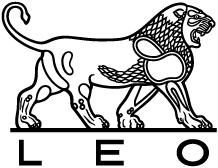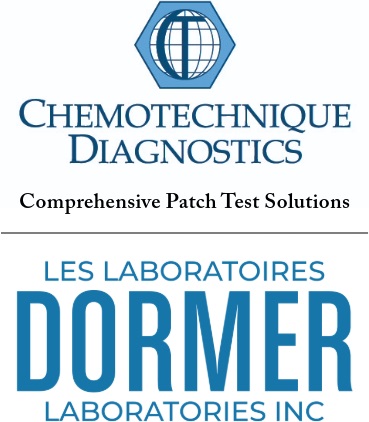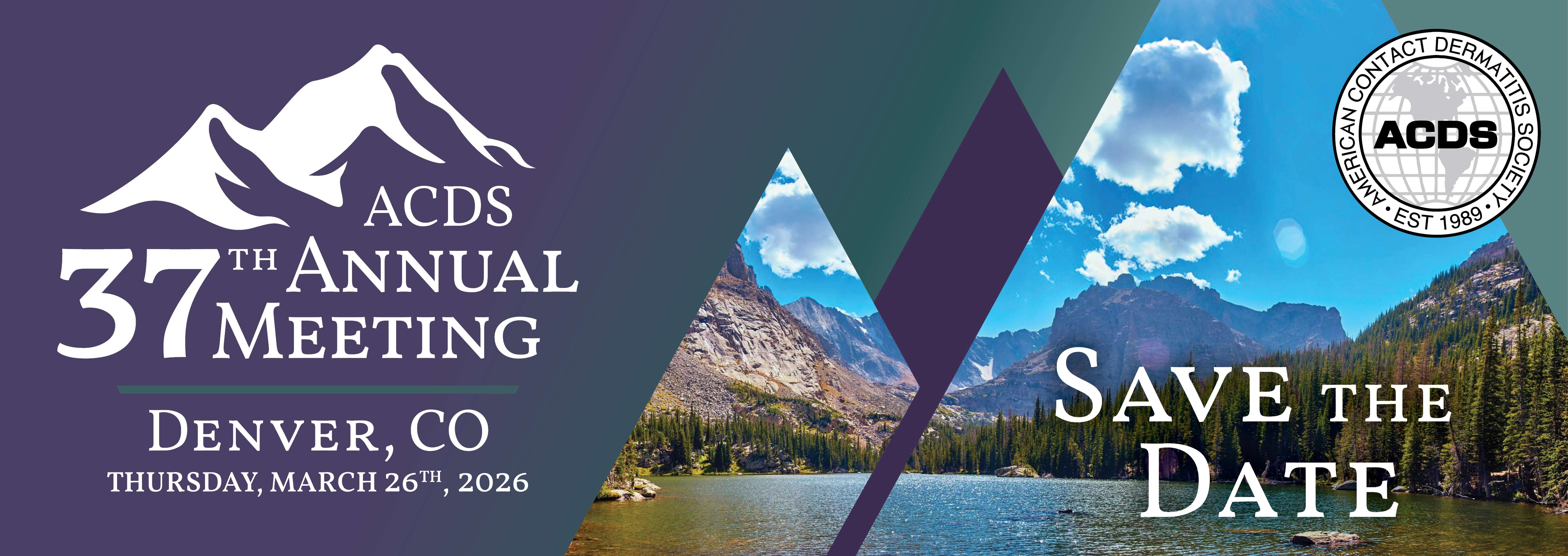
Inside this Issue· · · · · • ♦ • · · · · · Basics of Patch Testing Workshop Special Report from the 2025 AMA Annual Meeting New FREE Book from Dr. A.C. de Groot |
Message from the President
Dear ACDS Member:
I hope everyone and their families are enjoying a wonderful summer filled with trips, memories, and a little time to yourselves. We are hard at work at ACDS and would love to provide a few quick updates.
CAMP 2.0
CAMP 2.0 continues to be a roaring success amongst patients and providers. CAMP Director Dr. Atwater and her team continue to make critical updates including allergen information sheets, fixing bugs, and streamlining the user experience. As of this May, we have over 55,000 CAMP users with numbers continuing to grow by the thousands monthly. For other important CAMP updates, please reference here. We are continuing to work with our industry partners to identify strategic alliances that would benefit CAMP for years to come. If you have any industry partners that you think may be interested in partnering with CAMP, please let us know!
FDA Workshop
The FDA has engaged the ACDS in a workshop this October to discuss the current state of patch testing in the United States. The ACDS has been working with the AAD to carefully hone our message to demonstrate the significant benefit patch testing has on the lives of our patients, their occupations, and their families. This effort is led by Dr. Alexandra Flamm, the chair of our AMA & Health Policy Committee and president-elect of the ACDS. We are looking forward to sharing our viewpoint with the FDA.
Fall Meeting, October 17-18 in Charleston, SC
It's hard to think about the fall with the summer in full swing, but the much anticipated 2025 Fall Meeting is right around the corner. Taking place in historic Charleston, SC from October 17-18, this 2-day meeting will touch on many hot topics in dermatitis, from controversial topics (biologics and lymphoma development), to practical patient resources (AI assisted counseling?), to hearing from other specialties (oral medicine and orthopedics) on how they view contact dermatitis. For those that are new to patch testing or need a refresher, we are also offering a half-day patch testing workshop on Thursday, October 16th. For the full 2025 Fall Meeting agenda, please see here.
I hope everyone has a wonderful summer, and I can’t wait to see many of you in Charleston in October. It will be a beautiful time of year.
If you have member news or information you would like highlighted in a future ACDS Newsletter, please email it to info@contactderm.org.
Sincerely,

JiaDe (Jeff) Yu, MD, MS
ACDS President

American Contact Dermatitis Society
555 E. Wells Street, Suite 1100 | Milwaukee, WI 53202
Phone: (414) 918-9805 | Fax: (414) 276-3349 | Email: info@contactderm.org
www.contactderm.org
Early-Bird Registration Open until September 12!
We look forward to welcoming attendees to Charleston, SC for the ACDS 2025 Fall Meeting Friday, October 17 - Saturday, October 18, 2025, to be held at the Charleston Marriott.
· · · · · · · · · · · · • ♦ • · · · · · · · · · · · ·
Highlights
|
|
 |
|
|
|
|
|
View the current agenda* here or by clicking the image below!
*agenda subject to change
· · · · · · · · · · · · • ♦ • · · · · · · · · · · · ·
"Ask the Experts" Panel Discussion
Therapeutic Pearls in Unique Clinical Scenarios and "End of the Road" Patients
Have you tried what feels like everything to help your struggling patient with sub-optimal results? Submit your question in advance when registering online for our expert panel discussion to reveal therapeutic pearls for the most challenging cases. Panelists Amber R. Atwater, MD, Mark Davis, MD, Douglas Powell, MD, and JiaDe "Jeff" Yu, MD will be addressing questions from attendees submitted both in advance of the meeting and onsite.
· · · · · · · · · · · · • ♦ • · · · · · · · · · · · ·
Register Today!
In-person registration is OPEN! Please note that we will not be offering a virtual component for this event. There is an option to register - for an additional fee - for the half-day hands-on Basics of Patch Testing Workshop on Thursday, October 16th.
Early Bird registration ends at 11:59pm CST on September 12, 2025. Registration after this date will result in the regular rate being applied.
Meeting Registration RatesFriday, October 17 - Saturday, October 18, 2025 |
||
| Early Bird | Regular | |
| ACDS Physician Members | $295 | $350 |
| Non-Member Physicians | $395 | $450 |
| Industry Representative | $275 | $330 |
| Non-Physician Clinical Staff | $145 | $200 |
| Residents / Medical Students | $25 | $50 |
Basics of Patch Testing Workshop Registration RatesThursday, October 16, 2025 |
||
| Early Bird | Regular | |
| ACDS Physician Members | $75 | $100 |
| Non-Member Physicians | $125 | $150 |
| Industry Representative | $50 | $75 |
| Non-Physician Clinical Staff | $50 | $75 |
| Residents / Medical Students | $25 | $50 |
· · · · · · · · · · · · • ♦ • · · · · · · · · · · · ·
Basics of Patch Testing Workshop
Thursday, October 16, 2025
1:00pm - 4:00pm
ACDS is excited to offer a one half-day hands-on Basics of Patch Testing Workshop open to beginners and to those who desire a refresh. During this session, participants will:
- Receive didactic and interactive lectures from leaders within the American Contact Dermatitis Society
- Feel, touch, and load different patch testing chambers available on the market
- Mix and dispense allergens
- Patch test and map the backs of mannequins
- Observe an in-person interview of a patient with allergic contact dermatitis
- Feel and observe the reading and interpretation of patch testing results on a LIVE patient
The Basics of Patch Testing Workshop will be held in conjunction with the ACDS 2025 Fall Meeting in Charleston, SC. Space is limited and additional registration fees will apply.
 |
Thank you Dormer Laboratories, Inc. | Chemotechnique Diagnostics for sponsoring the Basics of Patch Testing Workshop! |
· · · · · · · · · · · · • ♦ • · · · · · · · · · · · ·
Resident Travel Award
The ACDS is excited to offer up to FIVE Fall Meeting Travel Awards for dermatology residents to attend both the Basics of Patch Test Workshop and the Fall Meeting General Sessions for FREE. An additional $1,000 towards travel related expenses is included.
For full award details, benefits, eligibility, and to apply, visit the ACDS website at www.contactderm.org/events/acds-fall-meetings/workshop/travel-award. Pass this information along to a resident who might be interested! Additional questions can be forwarded to info@contactderm.org.
Application Deadline: Monday, August 25, 2025
· · · · · · · · · · · · • ♦ • · · · · · · · · · · · ·
ACDS wishes to thank the following sponsors for their support of the ACDS 2025 Fall Meeting:
![]()
![]()
![]()
![]()
The Second Annual Rosalind Franklin Award: Celebrating the Accomplishments of Women in Science, Medicine and Dermatology!
Summer is here! As we are early in the Summer of 2025, we again have a reason for celebration! A prestigious award has again been bestowed upon the American Contact Dermatitis Society, its members and its flagship journal, Dermatitis®.
Here is some historical background:
On July 25, 1920, Rosalind Franklin was born. This year would be her 105th birthday if she were still alive today. Alas, she died in 1958. Rosalind was a British PhD chemist and X-ray crystallographer whose work was central to the understanding of the molecular structures of DNA, RNA, viruses, coal and graphite. Her contributions to the discovery of the structure of DNA were largely unrecognized during her life. She has been described as ”The dark lady of DNA” and the “Forgotten heroine”, because her seminal work on the structure of DNA was fundamental to the subsequent work of Watson and Crick, whose fame was related to their discovery of the DNA double helix.
What does this under-recognized scientist have to do with ACDS and Dermatitis®?
Our publisher, Mary Ann Liebert Inc., in partnership with the Rosalind Franklin Society (RFS, a national organization, www.rosalindfranklinsociety.org), again is hosting its prestigious annual award for the best paper by a woman in science or underrepresented minority in each of the publisher’s 100 peer-reviewed journals. The Award is known as the RFS Award in Science. We believe this is an important way to highlight the important contributions of these scientists and provide role models and mentors for younger scientists following in their footsteps.
The Award was launched 4 years ago in all of the Liebert journals in science, medicine, and biotechnology. Each winner receives $1,000 and a personalized certificate. All Award winners are announced in during the summer of each year, in honor of Rosalind Franklin’s birthday, and the RFS Society will again publish an anthology of their abstracts. In addition, the winners will be featured in interviews, speaking opportunities, and press releases.
Since 2025 represents our third full year of partnership with Liebert publishing house, Dermatitis® was invited as an “Editor’s Choice” to nominate an ACDS member who published an article in our journal in 2024. In collaboration with the ACDS publication committee, we selected our ACDS candidate for this prestigious award. Our unanimous nominee was Dr. Melanie Pratt, whose article is titled: "Occupational Contact Dermatitis in Construction Workers: A Retrospective Analysis of the North American Contact Dermatitis Group Data, 2001–2020" DERMATITIS, Vol 35 (5): 467-75 September/October 2024
 Melanie rose to the top of elite competition of women in science, biotechnology and medicine in the universe of Liebert journal publications to win this year’s award!
Melanie rose to the top of elite competition of women in science, biotechnology and medicine in the universe of Liebert journal publications to win this year’s award!
Melanie Pratt is a highly respected dermatologist and is well-known to the membership of the ACDS. She is based in Ottawa, Canada, and has dedicated her career to the care of patients with contact dermatitis. She has been director of the Ottawa Hospital Contact Dermatitis clinic since 1986, and is known for her expertise in this field, and has been full-time academic Professor of Dermatology at the Ottawa Hospital.
She completed her medical degree at the University of Ottawa and has extensive training with renowned dermatologists in the United States and the United Kingdom. Her contributions to dermatology have been recognized with numerous awards, including the Canadian Dermatology Association Lifetime Achievement award in 2020. She has been active in several professional organizations, such as the American Contact Dermatitis Society, the North American Contact Dermatitis Group and the International Contact dermatitis Research Group.
Congratulations, Melanie, for a well-deserved honor!
· · · · · · · · · · · · • ♦ • · · · · · · · · · · · ·
Call for Submissions on Chronic Hand Eczema (Hand Dermatitis):
Submit your study, review, case report, letter, Pearls & Zebras, Images related to Chronic Hand Eczema by December 31, 2025.
https://mc.manuscriptcentral.com/dermatitis
The editor of Dermatitis® is excited to bring to its readership a state-of-the-art comprehensive collection of reviews, studies, letters and Pearls and Zebras on Chronic Hand Eczema and its mechanisms. We especially encourage submissions of original studies in this topic although other types of manuscripts will be considered.
Areas of interest include: clinical trials, treatment modalities, epidemiology/population studies, health care disparities, skin of color, allergy/patch testing, basic science studies, and immunobiology as it related to chronic hand eczema. Case series or case reports will also be considered.
For further questions, please contact the Editor-in-Chief, Dr. Anthony Gaspari at: aagaspari@gmail.com, Professor, Department of Dermatology and Cutaneous Biology, Sidney Kimmel Medical College of Thomas Jefferson University.
· · · · · · · · · · · · • ♦ • · · · · · · · · · · · ·
Call for Manuscripts related to Practical Techniques:
We are pleased to announce that we have already received a number of submissions related to “Practical Techniques”, a new feature of our journal in which novel techniques are published. Our first articles related to this new section of the journal will be published in the July/August issue of Dermatitis® (issue 36.4). To remind our readers of what comprises a manuscript related to “Practical Techniques”, see below.
Dermatitis® is seeking manuscripts that will provide practical techniques about procedures used to evaluate or manage cutaneous allergy including contact dermatitis, type I allergic reactions, reactions to environmental agents or systemic reactions to medications. Examples may include, but are not limited to: novel methods for open or closed patch testing, scoring systems, clinical research methods, repeat open application tests, repeat insult patch tests, allergy alert tests, intradermal challenges, oral challenges, ocular challenges, extemporaneous formulations of patient-supplied materials for patch testing (such as personal care products, work-related products, materials derived from plants clothing, gloves, or other ‘non-standard’ allergens), skin prick testing, photo-patch testing, photo-testing, opportunities to increase the efficiency of patch testing, and novel patient counseling materials. As appropriate, the articles may include commercial sources of materials needed to perform the techniques discussed, provided any author(s) conflicts of interest are disclosed.
Manuscripts can be up to 3000 words in length, include up to three figures or tables (additional supplemental on-line only figures, tables and videos are permitted). Dr. Amber Atwater (Associate Editor for Contact Dermatitis domain of our journal) has generously agreed to oversee the review of these submissions.
We encourage our members to share their expertise related to modification of existing methods for diagnosing cutaneous allergy, and novel methods to enhance the patient experience, or increase the sensitivity of existing techniques (see above).
We are encouraging submissions because we want to see this as a regular feature of our journal. If there are any questions about the suitability of a potential article for this journal feature, please contact the Editor-in-Chief, Dr. Anthony Gaspari at: aagaspari@gmail.com, Professor, Department of Dermatology and Cutaneous Biology, Sidney Kimmel Medical College of Thomas Jefferson University, or our Associate Editor, Dr. Amber Atwater atwat012@gmail.com.
Submitted by:
Anthony Gaspari, MD
Dermatitis Editor-in-Chief
· · · · · · · · · · · · • ♦ • · · · · · · · · · · · ·
Published by Mary Ann Liebert, Inc. and led by Anthony Gaspari, MD, Dermatitis® is the leading peer-reviewed scientific journal in contact dermatitis, and the only journal in its field that publishes leading research in atopic, contact, occupational, environmental, and drug dermatitis.
The journal is an essential resource for dermatologists, allergists, immunologists, and toxicologists and is now available only from Mary Ann Liebert, Inc. - make sure you and your colleagues don't miss an issue!
Click here to request access from your institutional library now.
Special Report from the 2025 AMA Annual Meeting
Chicago, IL | June 7-11, 2025
The American Contact Dermatitis Society (ACDS) was proud to have a strong presence at the 2025 American Medical Association (AMA) Annual Meeting held in Chicago from June 7–11. ACDS delegate Dr. Bruce Brod and alternate delegate Dr. Jim Taylor were deeply engaged and highly visible in their advocacy efforts on behalf of ACDS and the broader Dermatology Section Council (DSC).
Between them, Bruce and Jim delivered extensive testimony in AMA reference committees underscoring ACDS’s leadership and commitment to advancing dermatologic and public health policy.
Key Advocacy Highlights
Fragrance Policy Reform
One of the most significant achievements was the successful adoption of testimony related to AMA Committee on Science and Public Health Report on fragrance policy. Bruce and Jim were instrumental in shaping the report to ensure it was grounded in evidence-based science. Their testimony secured language emphasizing the inclusion of relevant physician specialties in the development of voluntary fragrance policies for government and non-profit entities, an important step for patient safety and clinical relevance.
Food Allergen Disclosure
Bruce testified in support of urging the FDA to enhance public disclosure of both major and minor food allergens, with a focus on preventing systemic contact dermatitis.
Reducing Compliance Burdens
Bruce also testified on behalf of the AMA DSC advocating for the reduction of duplicative compliance training requirements imposed by hospitals, an issue affecting many practicing physicians. The policy was adopted by the AMA.
Support for OEM Training
Both Bruce and Jim testified in favor of continued NIOSH funding for Occupational and Environmental Medicine residency programs, recognizing their vital role in public health and workplace safety. NIOSH funding for these residencies is on the chopping block for the end of the month.
AI in Clinical Decision-Making
Jim contributed to the AMA’s evolving policy on artificial intelligence by attending the AMA Informatics Caucus meeting and testifying on a resolution which promotes transparency in AI systems used in clinical settings. There were several other resolutions passed on AI, emphasizing the importance of transparency, clinical and public safety and oversight in the adoption of AI programs. AI programs should be explainable, open and transparent, especially in needed oversight and regulation of AI. The AMA emphasizes Augmented Intelligence - identifying the importance of physician review and approval of AI programs. The AMA web site has excellent resources and statements on AI in medicine.
Board Certification Integrity
Bruce testified on behalf of the DSC on a resolution which could have undermined the integrity of board certification by legitimizing non-standard or “junk” boards. This helped preserve the high standards essential to maintaining public trust in the profession as the resolution was referred for further consideration and not adopted.
Bruce also served as the DSC lead for Reference Committee C (Medical Education), while Jim continues to be an influential member of the AMA’s AI Committee.
Emergency Resolution Spotlight
The meeting also featured the adoption of Emergency Resolution 1001 (A-25), introduced by a broad coalition of medical societies. This resolution calls for the AMA to advocate for the preservation of the current structure and independence of the Advisory Committee on Immunization Practices (ACIP), following recent controversial changes by the Secretary of Health and Human Services. The resolution emphasizes the importance of evidence-based, politically independent vaccine recommendations and includes directives for public advocacy, congressional engagement, and exploration of alternative advisory structures.
Looking Ahead
This year’s meeting was especially significant as Dr. Marta Van Beek, a dermatologist on faculty at the University of Iowa, won a seat on the AMA Board of Trustees.
Submitted by:
Bruce A. Brod, MD, MHCI, FAAD
Alex Flamm, MD, FAAD, Chair, ACDS Health Policy Committee
James S. Taylor, MD, FAAD
Monographs of Cosmetic Allergens
NEW FREE BOOK from Dr. A.C. de Groot
Anton de Groot has written a new book: Monographs of Cosmetic Allergens (May 2025). This 278-page e-book (searchable pdf; ISBN/EAN 9789081323390) is a 2017-2025 update of his previous publication Monographs in Contact Allergy, volume 1. Non-fragrance allergens in cosmetics. It presents literature data on 39 new non-fragrance contact allergens in cosmetics and updated information on 74 already known allergens that have caused allergic contact dermatitis from their presence in cosmetic products. The book is mainly about cosmetic allergy, but all non-cosmetic literature that the author came across during the screening of Contact Dermatitis and Dermatitis between September 2017 and March 2025 is also presented briefly in the cosmetic chapters.
Anton cordially invites you to download the complete book free of charge from his website: www.antondegroot.com/downloads. He appreciates receiving feedback with comments, suggestions, corrections or other content.
CAMP 2.0 Updates
Since the CAMP 2.0 launch last September we have welcomed almost 55,000 new and returning (1.0) users to the system – our numbers continue to increase daily. Not surprisingly, Friday is the biggest day for new user registrations. The CAMP team continues to act as a resource supporting both members and their patients with questions about CAMP 2.0, and we work hard to incorporate the feedback we receive into the improvements and updates we make to the system. A continued thank you for your patience and support during this transition and going forward as we make CAMP even better. Please read below for important updates and helpful CAMP tips:
Corticosteroid Cross-Reactor Changes
The CAMP Cross-Reactor Committee recently revised how CAMP is programmed to treat steroid groupings. The revisions follow the Baeck Classification system1 and now divide steroids into two groups:
Steroid Baeck Group 1/2: Contains Baeck groups 1 and 2 steroids including budesonide, hydrocortisone, prednisolone, prednisone, triamcinolone, fluocinonide, desonide, fluocinolone, and others.
Steroid Baeck Group 3: Contains Baeck group 3 steroids including betamethasone, clobetasol, desoximetasone, dexamethasone, mometasone, and others.
Additional flexibility allows you to select each of the above groups individually, or select “Steroid Restrictive” to exclude all steroids.
1. Allergy 2011;66:1367-74
New Allergen Print Feature
You now have the ability to print all Educational Handouts associated with a patient’s allergen list at the same time you share the patient’s safe list. Select “Print Allergen Sheets” on the Share Patient Safe List screen to open the print dialogue box. Choose which narratives you would like to include and select “Print” to generate a printable PDF with all narratives combined into one document.
Nickel-Free Diet Handout Now Available!
The CAMP team is excited to announce that the Nickel-Free Diet handout is now available! When creating a patient Safe List, you have the option to include the diet sheet for any patient with nickel or nickel sulfate on their list on the Select Allergen Information Sheets screen.
ACDS Staff Cannot Modify Allergen Lists or Recommend Products
A friendly reminder that ACDS staff does not have access to your patient’s information and cannot modify allergen search codes or make recommendations on the safety of products or ingredients. You can modify your patient’s allergen list in CAMP 2.0 by selecting Update & View. When prompted, enter the allergen search codes your patient is registered under to make any necessary changes to the allergens, cross-reactor groupings, or availability of allergen narratives.
Click here to read more about these updates
· · · · · · · · · · · · • ♦ • · · · · · · · · · · · ·
For additional CAMP resources and to watch tutorials, please visit the Learning Center here.
Questions about CAMP? Contact us at campinfo@contactderm.org.
Click here to view all recent CAMP updates
ACDS 2025 Clinical Research Award
Congratulations to the latest ACDS Clinical Research Award recipients, Dr. Dara Bakar and Dr. Isaac Li-Chi Chen!
Dara Bakar, MDTunable Microneedle Patches for Targeted Allergen Delivery to Langerhans Cells: A Novel Diagnostic Platform for Allergic Contact Dermatitis |
|
Isaac Li-Chi Chen, MDContact Hypersensitivity and Autoimmunity: Investigating Allergic Contact Dermatitis in Patients with Vitiligo |
· · · · · · · · · · · · • ♦ • · · · · · · · · · · · ·
Rosalind Franklin Society (RFS)
Dermatitis publisher, Mary Ann Liebert Inc., in partnership with the Rosalind Franklin Society recently awarded the 2024 RFS Awards in Science. This award recognizes outstanding contributions by women and underrepresented minorities across Mary Ann Liebert, Inc. peer-reviewed journals. It highlights the achievements of outstanding investigators who, early in their careers, were often overlooked simply because they did not fit traditional stereotypes of scientists, engineers, or medical researchers. We are excited to recognize an ACDS member recipient of this award.
 |
2024 RFS Award in ScienceMelanie D. Pratt, MD, FRCPC Occupational Contact Dermatitis in Construction Workers: A Retrospective Analysis of the North American Contact Dermatitis Group Data, 2001–2020 |
· · · · · · · · · · · · • ♦ • · · · · · · · · · · · ·
Dermatitis 2024 Article of the Year
View all past winners by visiting www.contactderm.org/resources/journal/aroy-award
Analysis of Contact Allergens in Polyvinyl Chloride Examination Gloves in the United StatesThomas Norman, BA DERMATITIS, Vol 35 • No 2 • March/April 2024 |
· · · · · · · · · · · · • ♦ • · · · · · · · · · · · ·
Congratulations to all of these outstanding members!
You can now purchase items displaying the ACDS logo!
ACDS has launched an online store through Lands’ End where you can purchase a variety of items with the ACDS logo embroidered, printed, etc. on the item(s).
Available items include...

...and more!
Order yours at
business.landsend.com/store/acds/
 |
|||
 |
 |
 |
 |









